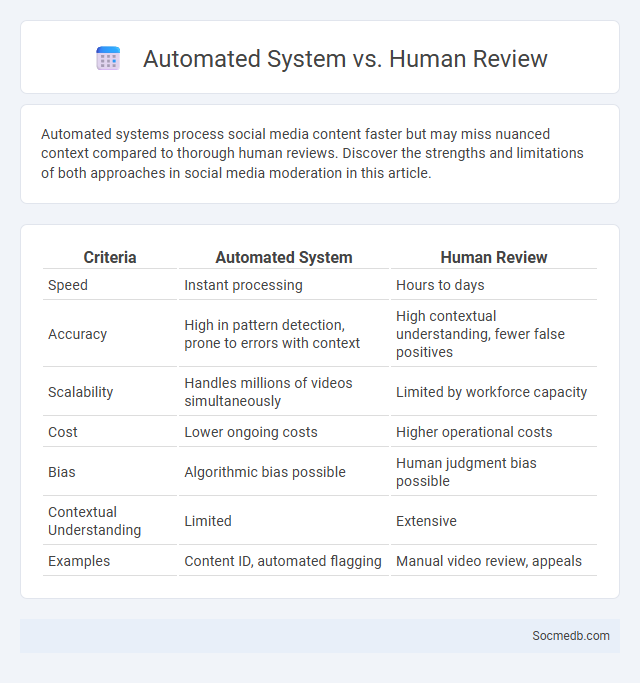
Photo illustration: Automated System vs Human Review
Automated systems process social media content faster but may miss nuanced context compared to thorough human reviews. Discover the strengths and limitations of both approaches in social media moderation in this article.
Table of Comparison
| Criteria | Automated System | Human Review |
|---|---|---|
| Speed | Instant processing | Hours to days |
| Accuracy | High in pattern detection, prone to errors with context | High contextual understanding, fewer false positives |
| Scalability | Handles millions of videos simultaneously | Limited by workforce capacity |
| Cost | Lower ongoing costs | Higher operational costs |
| Bias | Algorithmic bias possible | Human judgment bias possible |
| Contextual Understanding | Limited | Extensive |
| Examples | Content ID, automated flagging | Manual video review, appeals |
Understanding Automated Copyright Systems
Automated copyright systems on social media utilize advanced algorithms and machine learning to detect potential copyright infringements by scanning uploads for copyrighted content. These systems analyze metadata, audio fingerprints, and visual elements to identify protected material, enabling platforms to enforce copyright policies efficiently. Despite their effectiveness, automated systems sometimes generate false positives, highlighting the importance of appeals processes and human review for fair content management.
How Human Review Processes Work
Human review processes in social media involve trained moderators who assess reported content based on platform-specific guidelines and community standards. These reviewers analyze context, intent, and compliance with policies to determine if content should be removed, flagged, or left accessible. The combination of automated tools and human judgment helps maintain safe and respectful online environments while reducing false positives and ensuring nuanced decision-making.
Copyright Claims: Definition and Impact
Copyright claims on social media refer to legal complaints filed by content creators or rights holders when their original works are used without permission. These claims can result in the removal of videos, photographs, or audio tracks, affecting visibility and monetization opportunities for users. Social media platforms implement automated content identification systems, such as YouTube's Content ID, to detect and manage copyright infringements efficiently.
Advantages of Automated Detection Systems
Automated detection systems enhance social media platforms by swiftly identifying and removing harmful content, ensuring a safer online environment for Your interactions. These systems utilize advanced machine learning algorithms that continuously adapt to emerging threats, reducing the risk of misinformation and cyberbullying. By automating content moderation, social media companies can maintain user engagement and trust while efficiently managing large volumes of data.
Limitations of Human-Based Copyright Review
Human-based copyright review in social media faces significant challenges due to the immense volume of user-generated content, making real-time monitoring nearly impossible. Reviewers may also struggle with subjective interpretations and inconsistent enforcement of copyright laws across different jurisdictions. Your reliance on manual processes limits scalability and increases the risk of both false positives and undetected violations, underscoring the need for automated solutions.
Comparing Accuracy: Automation vs. Human Oversight
Automation in social media content analysis leverages machine learning algorithms to process vast datasets quickly but may struggle with contextual nuances and sarcasm, impacting accuracy. Human oversight enhances precision by interpreting complex emotions, cultural references, and ambiguous language, reducing false positives and negatives. Combining automated systems with expert human review achieves optimal accuracy in detecting trends, sentiment, and misinformation on social platforms.
False Positives and Negatives in Copyright Claims
False positives in social media copyright claims occur when legitimate content is mistakenly flagged or removed, causing unwarranted disruptions for content creators. False negatives happen when actual copyright infringements are overlooked, allowing unauthorized use of protected material to persist. Ensuring your content is properly identified and protected requires leveraging advanced detection algorithms and maintaining accurate metadata to minimize both false positives and negatives.
Legal Implications of Automated vs. Manual Review
Automated review systems on social media platforms often face legal challenges related to algorithmic bias and failure to contextualize content, risking violations of free speech and privacy laws. Manual review processes, while more nuanced, encounter issues with inconsistency and potential human error, which can lead to wrongful content removal or retention, impacting user rights. Compliance with regulations such as the Digital Services Act (DSA) and the Communications Decency Act (CDA) Section 230 remains critical for balancing content moderation with legal accountability.
Efficiency and Scalability in Copyright Management
Efficient copyright management on social media platforms leverages automated content identification and rights tracking technologies to quickly detect and address infringements. Scalability is achieved through AI-driven systems that manage vast volumes of user-generated content, ensuring consistent enforcement across global networks. Your content protection improves significantly when these tools minimize manual intervention and streamline rights administration.
Future Trends in Copyright Enforcement and Technology
Future trends in copyright enforcement will increasingly leverage artificial intelligence and blockchain technology to detect and prevent unauthorized use of content across social media platforms. You can expect advanced algorithms to analyze vast amounts of data in real-time, enabling quicker identification of infringements while ensuring the protection of creators' rights. Enhanced digital watermarking and decentralized content registration systems will offer more transparent and secure ways to manage intellectual property in the evolving social media landscape.
 socmedb.com
socmedb.com